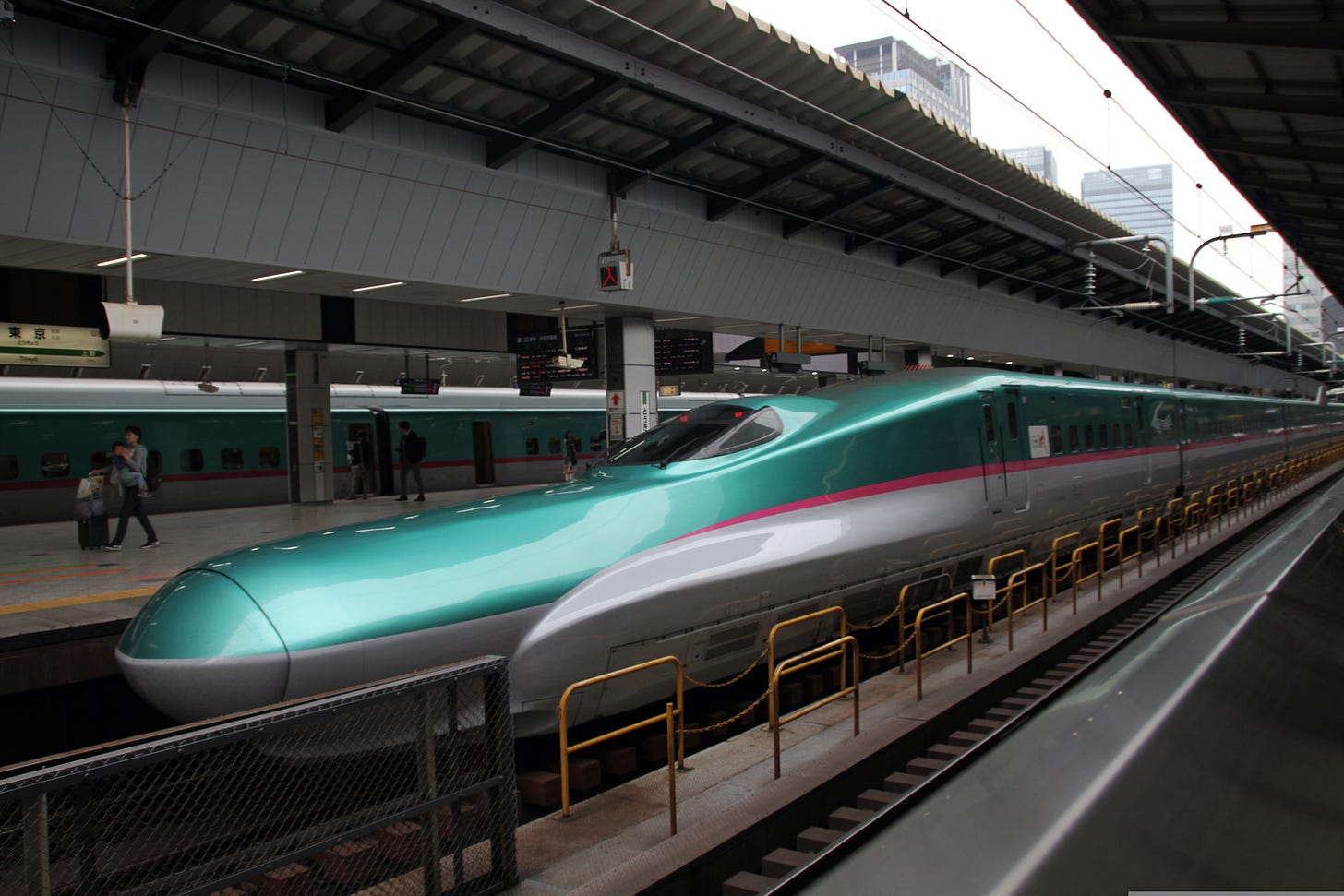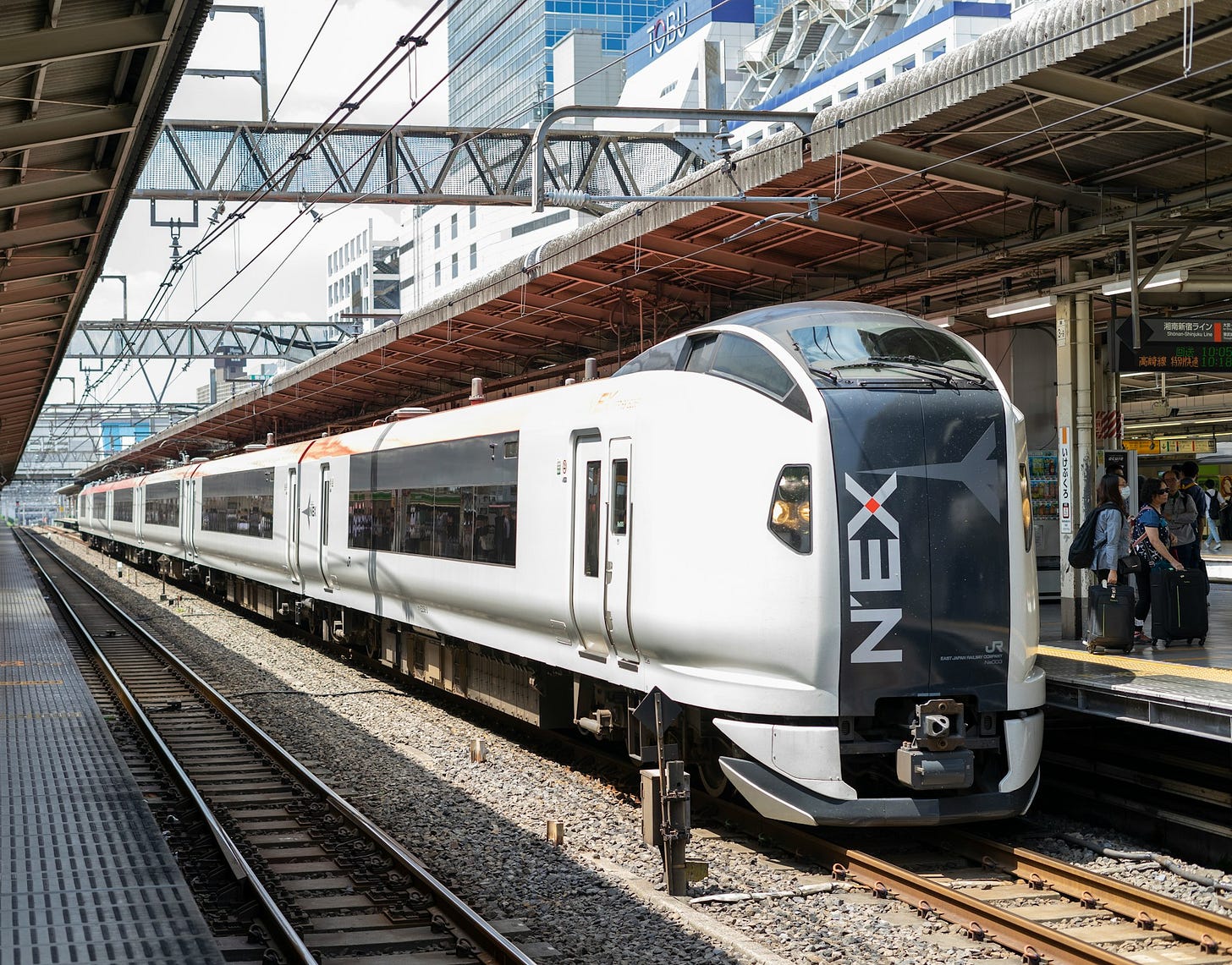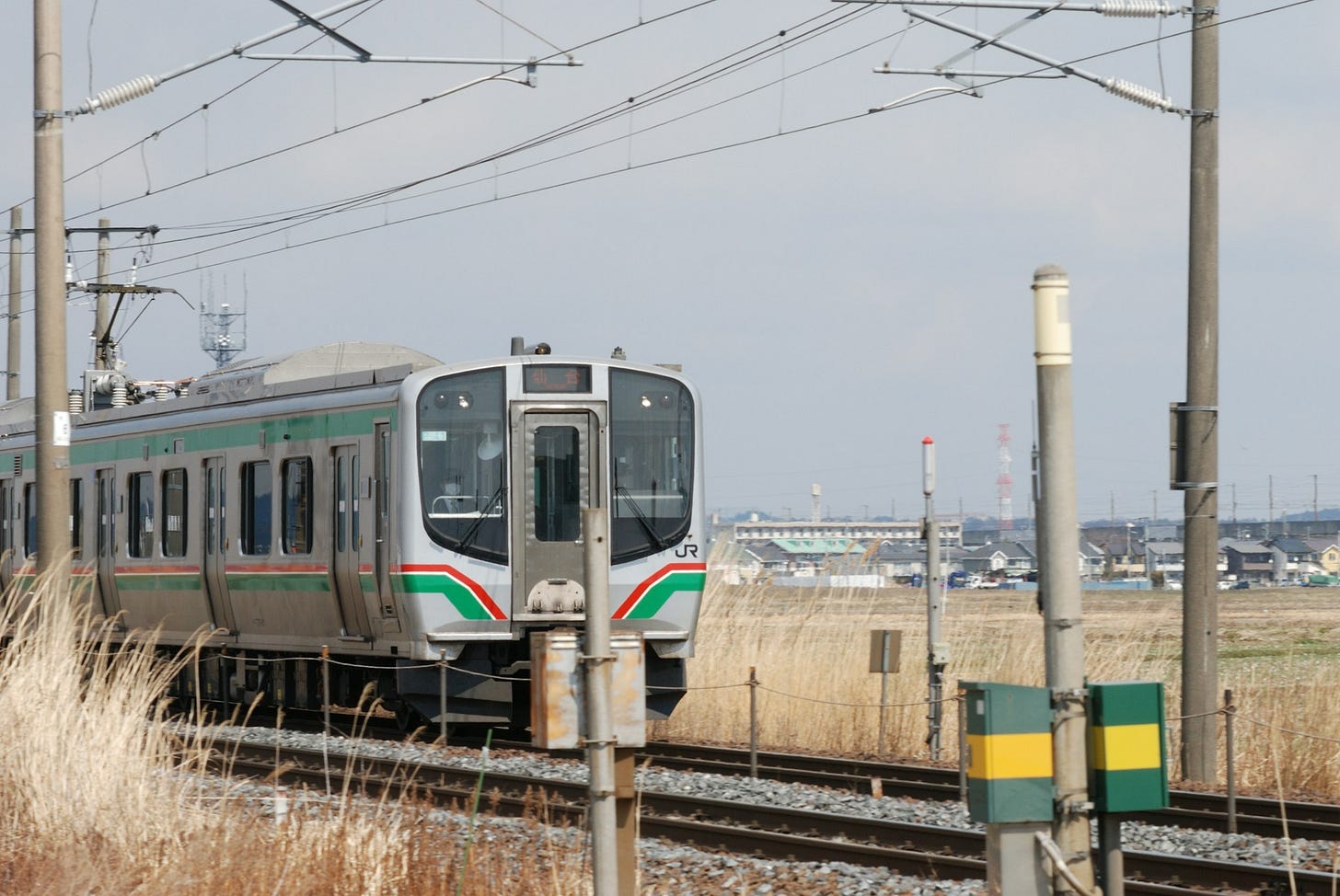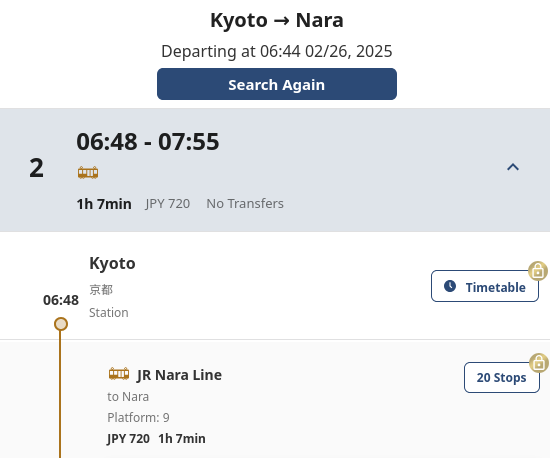Clueless to Fearless: Your No-Fuss Guide to Japan’s Trains
From route planning to finding your train, I'll make sure you don't go off the rails
Special announcement
My new e-book, Japan Out There: Kansai Edition, is out now.
It’s full of my favourite spots and hidden gems around Kyoto, Osaka, and Kobe.
Find out more below. ⬇️
Choosing where to visit on your Japan trip is hard enough, but when it comes to getting around, things can get complicated, fast. Most visitors will take at least one train while they’re here, so this month, let’s go over the basics for getting the most out of Japan’s insanely awesome railways. This advice is aimed at users of Japan Railways (JR) but much of it applies to other railways too.
Route planning: best tools for the job
If you’re like 99% of people, your first thought is probably to use Google Maps for route planning. While this tool can be very helpful for getting an idea of what a journey will involve, extended use is a lot like bringing a sausage to a knife fight.
Japan Route Finder & Planner by Navitime is a far better service for figuring out the best rail routes. I like how it plots the journeys on a map so you can get a better sense of how far you’re travelling. It also serves up the key information in an easy-to-read format. Some of the more helpful features may require a paid subscription, such as looking up timetables, but the most important bits are still free.
However, if you want access to things like timetables, just use the Japanese version of Jorudan, with autotranslate on in your browser.
Jorudan (Japanese version)
All the kinds of trains
Before we get into the nuts and bolts of train journeys, let’s make sure we know what we’re talking about.
Shinkansen refers to the high-speed bullet train.
A Limited Express is a quite fast cross-country train that makes limited stops.
Commuter trains are the most basic kind of trains, generally covering short distances.
Sounds easy, right? Well, Japan being Japan, there are subcategories to complicate matters.
Shinkansen trains come in different varieties. For example, on the Tokkaido Line between Tokyo and Shin-Osaka, Nozomi are the fastest, only stopping at major stations. Hikari are still quick, but stop at some less-important stations too. Kodama stop at every single station, so it’s best to avoid riding one for a long journey. You should only use one if you’re trying to reach a station not served by a Nozomi or Hikari.
Commuter trains also have different varieties. If it’s called a “Local” train, it will stop at every single station. If it’s called a “Rapid”, it probably skips quite a few stops. In the Kansai area you can find “Special Rapids”, which have even fewer stops than the “Rapid”. In other areas the names might be different, but the concepts are the same.
Over relatively short distances, a Rapid train can be worth taking over a Local, even if you have to wait a few more minutes on the platform. It will make up those lost minutes very easily. Just check your journey planner if you’re not sure.
All the kinds of seats
Before we can talk about tickets, we have to get you up to speed on seats.
Trains split their carriages between different classes, so there is the Green Car, reserved, and non-reserved.
Non-reserved seats
If you don’t have a seat reservation, you have to sit in a non-reserved car.
Non-reserved seats are the cheapest, because there’s no guarantee that you’ll get a seat. You can’t go and sit in an unoccupied seat in the reserved seat car. If you do that, you’ll get turfed out before long. This is a bit different to trains in the UK for example, where having a seat reservation is largely meaningless, as conductors rarely turf people out of seats, and passengers rarely cause a fuss.
On the Tokaido Shinkansen between Tokyo and Shin-Osaka, and actually further south towards Hiroshima, finding a seat in non-reserved cars can be quite difficult. On the last train of the day, I’ve even seen people standing in the aisles.
If you’re using a non-reserved ticket, you can increase the chances of you getting a seat by lining up on the platform at least 15 minutes before the train arrives. If you’re at the head of the queue, you get first dibs on any free seats.
Reserved seats
Predictably, reserving a seat costs more money. Not much though, and it’s worth it to guarantee you can rest after a long day of sightseeing.
On the Shinkansen, seat rows are generally arranged in a 2-3 setup. Of course, sitting in one of those 2 seats is preferable because you only get one neighbour, but they book up fast. Over on the other side of the aisle, nobody wants the middle seat in that set of 3, but you should know that it’s actually wider than all other seats!
If you’re bringing luggage with you, it’s a good idea to book seats at the very ends of cars so you can put it behind or in front of you. This is highly recommended for Limited Express trains, because they don’t always have that much space - although the ones going to airports always have plenty of special luggage racks.
On the Shinkansen, it’s complicated, so watch this video:
It’s worth noting that if you have a seat reservation, you can still go and sit in a non-reserved car. Your neighbour in the reserved car might have brought a Big Mac and fries on board (it’s happened to me), in which case, finding a better seat in non-reserved is just fine.
Green Car
First class is known as “the Green Car” on JR trains. I find most people taking the Green Car want either comfort or quiet, and sometimes both. It’s pretty expensive though. I made a video about the Green Car, so watch it if you want to know more.
Gran Class
On the Shinkansen north of Tokyo, they have “Gran Class”. It’s like the Green Car on steroids. Totally unnecessary, hugely expensive, yet people still use it. I tried it once, and it was a bit like going to a theme park: lots of excitement, and then it was over.
Should I buy tickets in advance, and when?
This is one of those “how long is a piece of string?” questions. Let’s look at some situations.
Shinkansen
If you’re planning on using a non-reserved seat, you can just roll up at the station, buy a ticket, and get on.
If you’re getting on where a train starts (at the end of a line), like Tokyo, Hakata, Kagoshima-Chuo, Shin-Hakodate Hokuto, or Shin-Osaka, non-reserved cars will begin empty. This means you can just line up early and snag a seat.
And if you’re boarding at major stations along the way, like Hiroshima, Okayama, Nagoya, or Sendai, you’ll probably have a decent chance at getting a seat. That’s because a lot of people tend to get off at those stations.
But if you want to guarantee a seat, you can book up to one month in advance. If you use Smart EX, you can book up to a year beforehand. However, in reality, something between a week to a couple of days beforehand is sufficient.
The big exception is when you’re travelling during “Golden Week” at the end of April and start of May, Obon in August, or around and during the New Year. If that includes you, then book ASAP. Like now. During those times, Nozomi Shinkansen go fully-reserved, leaving only Hikari and Kodama with non-reserved seats. Don’t get stuck on a Kodama, remember!
If you want to use the large luggage areas, it’s also better to book early, since seats allowing use of those spaces do sell out, especially in peak seasons.
Limited Express trains
Increasingly, these trains are becoming all reserved seaters. Since you can’t reserve seats on board, you need to do it beforehand.
During Cherry Blossom season, some of these kinds of trains book up, especially if they’re going to popular spots, such as Lake Kawaguchi (with a famous view of Mount Fuji).
My advice would be to book ASAP (tickets are available one month before the train departs).
Commuter trains
No. You don’t need reservations.
You might be surprised by this, but many popular routes are only served by commuter trains.
This means you don’t need to go to the ticket office - just buy a ticket at the machine, or use an IC card to pay (more on this later).
Once, I met a family in Kyoto Station who wanted to go to Nara. They thought they should go to the ticket office for this.
But Kyoto to Nara is a commuter train journey.
You can figure this out by looking at the journey planner result. JPY 720 is the fare, so 720 yen.
But for this train between Kyoto and Amanohashidate, there’s an extra price there for a reserved seat charge, 1530 yen.
One mistake I see a lot in itineraries is people planning to take the Shinkansen or a Limited Express between Kyoto and Osaka.
This is amusing for me, since it’s overkill. It’s also not necessarily quicker.
The fastest JR commuter train only takes 29 minutes and runs about every 15 minutes. If you took the Shinkansen, by the time you’d finished walking over to the platform, you could already be about half way to Osaka on the Special Rapid.
Where to buy tickets
Frustratingly, there’s no central location for booking all train journeys in Japan with JR. Well, there is, but it’s called the ticket office or machine.
I explain about the different places to use for buying tickets online in the video below. Klook has got a lot better since making it, now allowing for things like choosing seats. If you do go the Klook route, use my coupon code to get some money off: JPUNRVLDKLOOK
Do I need a rail pass?
It depends. To check if it is cost-efficient to buy one of the many, many passes offered by Japan Railways (JR), you should use a pass calculator like the handy one at Japan Guide. Remember though that even if you have a set itinerary, it’s always good to have some flexibility for impromptu trips. Once I arrived in Tokyo Station in the early morning ready for some sightseeing, but after seeing so many people in the station, I got on the first Shinkansen up to Niigata. That’s the power of having a rail pass - go wherever you want, whenever you like.
How to find your train
When you arrive at the station, there’s usually a big departure board that cycles between Japanese and English. It can be quite a task to find the train you want.
What I generally do is look for the departure time. I usually know this from looking up the route online beforehand, and finding the matching time finds me the right platform.
Route planners, and yes, even Google Maps can tell you the correct platform. But it’s always good to double-check with the departure board.
Extra Pro-tips
Return tickets aren’t really a thing
This confused me when I first arrived in Japan, but the system generally works on single tickets. So you need to buy two separate tickets to do a return journey.
You can eat on them
If your seat has a table, you can eat food. That’s the general rule. Commuter trains seldom have tables, so don’t dare break out your lunch. Drinks are fine though.
Just get an IC card
An IC card is a credit card sized prepaid transport pass. You load it with cash beforehand, “tap” it at the ticket gates when you enter, and again when you reach your destination. The system calculates your fare automatically and deducts the amount.
Popular IC cards are ICOCA, TOICA, and SUICA.
If you’re an iPhone user, you can get ICOCA and SUICA digital versions by adding one in your iPhone wallet settings. Android users, no, you can’t. Sorry.
I explain more in this video below.
Shinkansen Shortcut
If you can’t use Smart EX to buy your Shinkansen ticket, you might find yourself waiting in a long queue for the ticket machine or office.
You don’t need to do this.
Whip out your IC card, and go through the gates for the commuter trains.
Then head for the Shinkansen transfer gate. There you’ll find machines for booking Shinkansen tickets.
The machine will ask for your IC card to cancel the entrance you just made, and give you proper tickets. Then you just go get on the Shinkansen. No queueing required!
Get My Help
If your goal is an epic, one-of-a-kind trip in Japan, I can help.
Paid consultations are available now.
Have a Unique Adventure, the Easy Way
Attention discerning Japan travellers!
You want to have a one-of-a-kind adventure, packed with hidden gems and free from crowds, right?
I’ve got just the thing for you:
Japan Out There: Kansai Edition.
This e-book is my hand-picked selection of the greatest secret treasures from off-the-beaten path.
It covers the area around Kyoto, Osaka, Nara, and the rest of the Kansai region.
Use the code “DENSHA” to get 50% off - only for the first 5 people!
Trip Essentials
Everything you need in one place - get ready and support my work at the same time!
Basics: eSIM / Sim Card / Pocket Wifi / VPN / Travel Insurance
Youtube: Get ready for Japan playlist
Transport: JR Pass / Regional Passes / Shinkansen Tickets / Car rental
That’s all for this month! See ya!
Andrew
*There are some affiliate links in this email: I will earn a small commission if you buy something, and it costs you nothing. Cheers!












This post was so thorough and I needed it to be so because I'll visit Japan for the first time this summer! Sincere thanks!
Really useful and practical information and advice, Andrew. Many thanks!